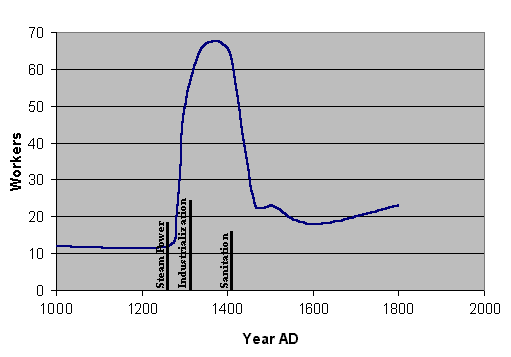What is the consensus on the ideal worker/city ratio?
This would obviously differ between industrious and non-industrious civs. It would also depend on the pop growth of the particular city.
Also, is it better to build as many workers as possible so as to finish improving all your city tiles as quickly as possible then have the workers rejoin their cities when they are all done?
Or is it better to keep the smallest amount of workers such that they are improving tiles at about the same rate as the pop is growing?
The first strategy would guarantee that you completely improve the tiles in all your empire as quickly as possible. However, you would have so many workers that your cities would not have as high a pop as they could have until the workers rejoin them.
The second strategy seems to be more efficient, because it seeks to match the number of improved tiles to the pop size. Keeping the number of workers as small as possible allows your cities to have the highest pop possible while still improving tiles at a good rate.
I would suggest that the trick is to try to keep the number of improved tiles equal to your pop. If you have more improved tiles than pop then you have improved tiles that are not being used yet. You probably have too many workers and could have a couple rejoin the city so as to use those extra improved tiles.
On the other hand, if you have more pop than improved tiles, then you have pop n tiles that are not improved yet, thus you are not getting the max of ressources that you would be getting if the tiles were improved.
So it seems to me that the most efficient method is somewhere in between where you have approximately the same number of worked tiles as number of pop, and your workers improve tiles at about the rate of pop growth.
Am I right? Thoughts?
This would obviously differ between industrious and non-industrious civs. It would also depend on the pop growth of the particular city.
Also, is it better to build as many workers as possible so as to finish improving all your city tiles as quickly as possible then have the workers rejoin their cities when they are all done?
Or is it better to keep the smallest amount of workers such that they are improving tiles at about the same rate as the pop is growing?
The first strategy would guarantee that you completely improve the tiles in all your empire as quickly as possible. However, you would have so many workers that your cities would not have as high a pop as they could have until the workers rejoin them.
The second strategy seems to be more efficient, because it seeks to match the number of improved tiles to the pop size. Keeping the number of workers as small as possible allows your cities to have the highest pop possible while still improving tiles at a good rate.
I would suggest that the trick is to try to keep the number of improved tiles equal to your pop. If you have more improved tiles than pop then you have improved tiles that are not being used yet. You probably have too many workers and could have a couple rejoin the city so as to use those extra improved tiles.
On the other hand, if you have more pop than improved tiles, then you have pop n tiles that are not improved yet, thus you are not getting the max of ressources that you would be getting if the tiles were improved.
So it seems to me that the most efficient method is somewhere in between where you have approximately the same number of worked tiles as number of pop, and your workers improve tiles at about the rate of pop growth.
Am I right? Thoughts?



Comment